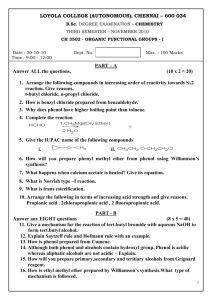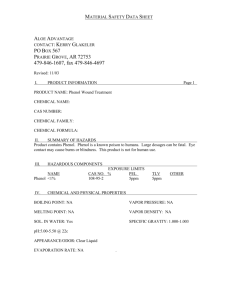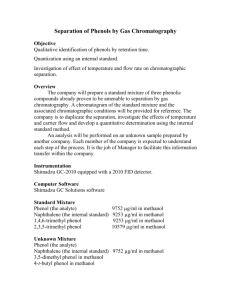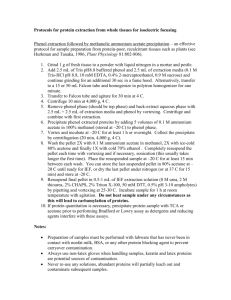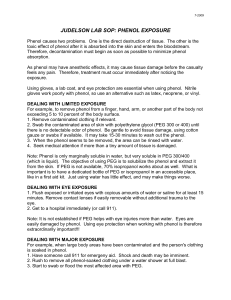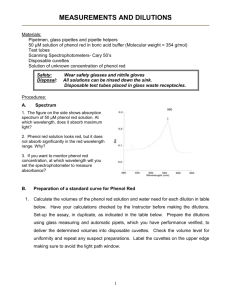Determination of the intermolecular geometry of the phenol
advertisement
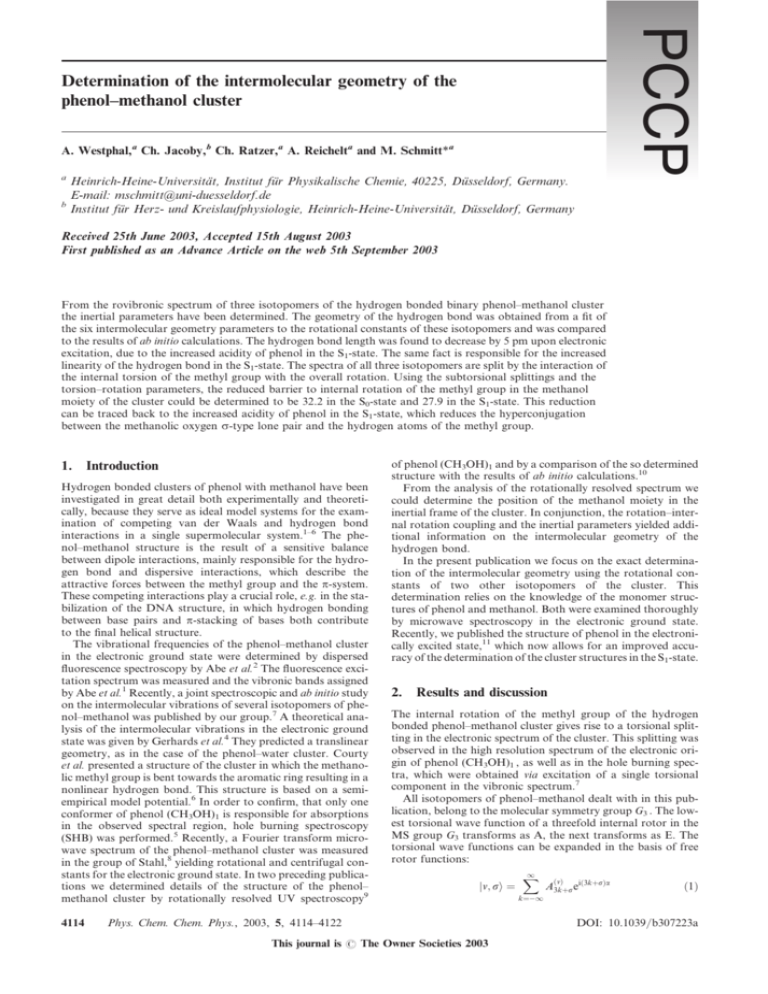
PCCP Determination of the intermolecular geometry of the phenol–methanol cluster A. Westphal,a Ch. Jacoby,b Ch. Ratzer,a A. Reichelta and M. Schmitt*a a b Heinrich-Heine-Universität, Institut für Physikalische Chemie, 40225, Düsseldorf, Germany. E-mail: mschmitt@uni-duesseldorf.de Institut für Herz- und Kreislaufphysiologie, Heinrich-Heine-Universität, Düsseldorf, Germany Received 25th June 2003, Accepted 15th August 2003 First published as an Advance Article on the web 5th September 2003 From the rovibronic spectrum of three isotopomers of the hydrogen bonded binary phenol–methanol cluster the inertial parameters have been determined. The geometry of the hydrogen bond was obtained from a fit of the six intermolecular geometry parameters to the rotational constants of these isotopomers and was compared to the results of ab initio calculations. The hydrogen bond length was found to decrease by 5 pm upon electronic excitation, due to the increased acidity of phenol in the S1-state. The same fact is responsible for the increased linearity of the hydrogen bond in the S1-state. The spectra of all three isotopomers are split by the interaction of the internal torsion of the methyl group with the overall rotation. Using the subtorsional splittings and the torsion–rotation parameters, the reduced barrier to internal rotation of the methyl group in the methanol moiety of the cluster could be determined to be 32.2 in the S0-state and 27.9 in the S1-state. This reduction can be traced back to the increased acidity of phenol in the S1-state, which reduces the hyperconjugation between the methanolic oxygen s-type lone pair and the hydrogen atoms of the methyl group. 1. Introduction Hydrogen bonded clusters of phenol with methanol have been investigated in great detail both experimentally and theoretically, because they serve as ideal model systems for the examination of competing van der Waals and hydrogen bond interactions in a single supermolecular system.1–6 The phenol–methanol structure is the result of a sensitive balance between dipole interactions, mainly responsible for the hydrogen bond and dispersive interactions, which describe the attractive forces between the methyl group and the p-system. These competing interactions play a crucial role, e.g. in the stabilization of the DNA structure, in which hydrogen bonding between base pairs and p-stacking of bases both contribute to the final helical structure. The vibrational frequencies of the phenol–methanol cluster in the electronic ground state were determined by dispersed fluorescence spectroscopy by Abe et al.2 The fluorescence excitation spectrum was measured and the vibronic bands assigned by Abe et al.1 Recently, a joint spectroscopic and ab initio study on the intermolecular vibrations of several isotopomers of phenol–methanol was published by our group.7 A theoretical analysis of the intermolecular vibrations in the electronic ground state was given by Gerhards et al.4 They predicted a translinear geometry, as in the case of the phenol–water cluster. Courty et al. presented a structure of the cluster in which the methanolic methyl group is bent towards the aromatic ring resulting in a nonlinear hydrogen bond. This structure is based on a semiempirical model potential.6 In order to confirm, that only one conformer of phenol (CH3OH)1 is responsible for absorptions in the observed spectral region, hole burning spectroscopy (SHB) was performed.5 Recently, a Fourier transform microwave spectrum of the phenol–methanol cluster was measured in the group of Stahl,8 yielding rotational and centrifugal constants for the electronic ground state. In two preceding publications we determined details of the structure of the phenol– methanol cluster by rotationally resolved UV spectroscopy9 4114 of phenol (CH3OH)1 and by a comparison of the so determined structure with the results of ab initio calculations.10 From the analysis of the rotationally resolved spectrum we could determine the position of the methanol moiety in the inertial frame of the cluster. In conjunction, the rotation–internal rotation coupling and the inertial parameters yielded additional information on the intermolecular geometry of the hydrogen bond. In the present publication we focus on the exact determination of the intermolecular geometry using the rotational constants of two other isotopomers of the cluster. This determination relies on the knowledge of the monomer structures of phenol and methanol. Both were examined thoroughly by microwave spectroscopy in the electronic ground state. Recently, we published the structure of phenol in the electronically excited state,11 which now allows for an improved accuracy of the determination of the cluster structures in the S1-state. 2. Results and discussion The internal rotation of the methyl group of the hydrogen bonded phenol–methanol cluster gives rise to a torsional splitting in the electronic spectrum of the cluster. This splitting was observed in the high resolution spectrum of the electronic origin of phenol (CH3OH)1 , as well as in the hole burning spectra, which were obtained via excitation of a single torsional component in the vibronic spectrum.7 All isotopomers of phenol–methanol dealt with in this publication, belong to the molecular symmetry group G3 . The lowest torsional wave function of a threefold internal rotor in the MS group G3 transforms as A, the next transforms as E. The torsional wave functions can be expanded in the basis of free rotor functions: jv; si ¼ Phys. Chem. Chem. Phys., 2003, 5, 4114–4122 This journal is # The Owner Societies 2003 1 X ðvÞ A3kþs eið3kþsÞa ð1Þ k¼1 DOI: 10.1039/b307223a where v is the torsional state index and the integer s takes on the values 0 and 1 for A and E levels, respectively. k runs over a limited number of basis functions. Generally 50 to 100 basis functions are sufficient for an accuracy of 0.1 cm1 in the determination of the energy of the torsional levels. The selection rule for torsional transitions is Ds ¼ 0, because the transition dipole moment is independent of the torsional angle a for the symmetric rotors –CH3 and –CD3 , which results in the observed transitions A $ A and E $ E. The experimentally determined A–E splitting in the spectrum of the electronic origin is the difference between the A $ A and E $ E rovibronic origin frequencies. The nuclear spin wave functions Cns transform as 4A + 2E for the –CH3 group and as 11A + 8E for –CD3 . The overall wave functions for both rotors transform as A, thus the spin statistical weights of the A and E subbands are 1:1 for phenol (CH3OH)1 and 11:16 for phenol (CD3OH)1 and [7-D]phenol (CD3OD)1 . Traces a, c and e of Fig. 1 show the R2PI spectra of phenol (CH3OH)1 , phenol (CD3OH)1 , and [7-D]phenol (CD3OD)1 in the region of the intermolecular vibrations, the traces b, d, and f show the respective high resolution LIF spectra of the electronic origins. At first sight, the rotationally resolved spectra of the electronic origins of phenol (CD3OH)1 and [7-D]phenol (CD3OD)1 seem to be less congested, compared to phenol (CH3OH)1 . The reason is a very small splitting of the subtorsional components, leaving a spectrum, which resembles closely the spectrum of an unperturbed rigid rotor. We performed an autocorrelation of the experimental spectra, in order to obtain the subtorsional splittings. Fig. 2 shows the results of the autocorrelations of the electronic origins of phenol (CH3OH)1 , phenol (CD3OH)1 , and [7-D]phenol (CD3OD)1 . In addition to the autocorrelation peak at zero lag, a broad, not very marked side peak is found for phenol (CH3OH)1 at a distance of 3550 MHz, in excellent agreement with the splitting determined from an assigned fit of the rovibronic spectrum.9 For phenol (CD3OH)1 the side peak is almost as narrow as the autocorrelation peak and has a considerably high intensity. The subtorsional splitting in this case amounts to 440 MHz. Such a narrow, intense side peak in the autocorrelation function is an indication of very similar subspectra, i.e. very similar molecular constants of the subspectra. In the case of [7-D]phenol (CD3OD)1 no side peak can be found at first sight. Closer inspection of the autocorrelation peak shows, that it is comprised of the main band at zero frequency lag and two side lobes at approximately 70 MHz. Also in this case the side peaks are narrow and intense, indicating similar torsional subspectra. Using the information about the size of the subtorsional splitting, it is quite straightforward to assign the rovibronic lines of each of the isotopic clusters, although the individual spectra are rather congested. The frequencies of the A-rovibronic lines were fit to the Hamiltonian for a distortable rotor in Watson’s A-reduced form:12,13 ^ ðAÞ ¼ Avs P 2 þ Bvs P 2 þ Cvs P 2 H vs a b c DJ P 4 DJK P 2 Pa2 DK Pa4 2dJ P 2 ðPb2 Pc2 Þ dK Pa2 ðPb2 Pc2 Þ þ ðPb2 Pc2 ÞPa2 ð2Þ in which the effective rotational constants Avs , etc. incorporate the second order torsional perturbation coefficients for a given torsional state |v,si.9 The E-rovibronic lines were fit to the Hamiltonian from eqn. (2), which is extended by the Fig. 1 R2PI spectra (trace a, c, e) of three isotopomers of the phenol–methanol cluster in the region of the intermolecular vibrations and corresponding HRLIF spectra (trace b, d, f) of the electronic origins. Phys. Chem. Chem. Phys., 2003, 5, 4114–4122 4115 Fig. 2 Autocorrelation of the rotationally resolved LIF spectra of the electronic origins of phenol (CH3OH)1 , phenol (CD3OH)1 and [7D]-phenol (CD3OD)1 . torsion–rotation parameters Dg , which are the coefficients of linear terms in the overall angular momenta Pg :14,15 ^ ðEÞ ¼ Avs P 2 þ Bvs P 2 þ Cvs P 2 H vs a b c DJ P 4 DJK P 2 Pa2 DK Pa4 2dJ P 2 ðPb2 Pc2 Þ dK Pa2 Pb2 Pc2 þ Pb2 Pc2 Pa2 þ Da Pa þ Db Pb þ Dc Pc ð3Þ Figs. 3 and 4 show the rotationally resolved electronic origins of phenol (CD3OH)1 and [7-D]phenol (CD3OD)1 along with the fits of both subtorsional components. In Table 1 the inertial parameters of phenol (CD3OH)1 , [7-D]phenol (CD3OD)1 and for comparison also the previously published parameters of phenol (CH3OH)1 are reported, which were obtained from the fit. For [7-D]phenol (CD3OD)1 the torsion–rotation parameters Dg were too small to be determined. For phenol (CD3OH)1 our fit did not converge when the torsion–rotation constant Db was included in the fit. Nevertheless, fits with all Dg fitted, but Db set to zero in both electronic states, resulted in the lowest w2. The subtorsional splittings determined from the assigned line fits are in good agreement with the values, which are observed in the autocorrelation functions of the rovibronic spectra (Fig. 2). The relative intensities of the bands are difficult to adjust, due to many overlapping rovibronic transitions, which contribute to the individual bands in the spectrum. Three factors have been considered, in order to reproduce the experimental intensities: the rotational temperature, the angle of the transition dipole moment with the inertial axes, and the nuclear spin statistics. The spin statistical weights are fixed to an intensity ratio of 11:16 for the A and E subbands of phenol (CD3OH)1 and [7-D]phenol (CD3OD)1 , as explained above. The squared direction cosines of the 4116 Phys. Chem. Chem. Phys., 2003, 5, 4114–4122 transition dipole moment vector with the inertial axes have been calculated for phenol (CD3OH)1 and [7-D]phenol (CD3OD)1 using the geometry of phenol (CH3OH)1 from ref. 9. The transition dipole in the phenol moiety of the cluster is assumed to have the same direction as in the uncomplexed phenol monomer. The temperature has been adjusted by manually changing this parameter and inspection of the gross intensities in the simulated and experimental spectrum. It could be determined to be 1.5 K. 2.1. Intermolecular geometry The effective rotational constants Avs, etc., which are given in Table 1 for the A- and the E-states (the torsional state under consideration here is v ¼ 0 in S0 and S1-state.) have to be corrected for the torsional perturbation, in order to obtain the geometric rotational constants. They are obtained as the weighted means of the s ¼ 0 and s ¼ 1 inertial parameters: 1 2 A ¼ Av0 þ Av1 3 3 etc: ð4Þ The so determined geometric rotational constants for phenol (CH3OH)1 (h5), phenol (CD3OH)1 (d3) and [7-D]phenol (CD3OD)1 (d5), which are used for the structure determination are given in Table 2. The determination of geometries from rotational constants depend critically upon the correlation which might exist between the inertial parameters. As the rovibronic spectra are of a/b/c-type there are no redundancies in the determination of the inertial parameters. The correlation matrix which gives indications for dependences between the parameters has been checked and no off-diagonal elements greater than 0.8 are found, so that the parameters can be viewed as independent. The relative orientation of the phenol and the methanol moiety can be described by six geometry parameters (one Fig. 3 Rotationally resolved LIF spectrum of phenol (CD3OH)1 along with the simulation, using the parameters from Table 1. The individual traces show (a) the experimental rovibronic spectrum of the electronic origin; (b) expanded part of (a) from 5000 to +10 000 MHz around the origin of the s ¼ 0 torsional component; (c) the simulation as the sum of the s ¼ 0 and s ¼ 1 torsional components with spin statistical weights of 11:16; (d) the simulation of the s ¼ 0 torsional component; (e) the simulation of the s ¼ 1 torsional component. distance, two angles, and three dihedral angles). The structure of the phenol moiety in the electronic ground state of the cluster is constrained to the geometry, determined by microwave spectroscopy by Larsen,16 and in the electronically excited state to the S1-state geometry, determined by Ratzer et al. using HRLIF.11 The structure of the methanol moiety is supposed not to change upon electronic excitation and has been kept fixed for both electronic states to the MW-geometry, determined by Gerry et al.17 We defined the internal coordinates of the cluster as shown in Fig. 5 and fitted the six intermolecular parameters to the nine rotational constants of three isotopomers, using our self developed program pKrFit.11 Geometry models, which can be utilized with this program are the r0-geometry, which neglects vibrational effects from the different isotopomers, the pseudo-rs-structures,18 which consider vibrational effects through equal vibrational contributions for all isotopomers; ð1Þ ð2Þ and Watsons mass weighted rm and rm; -structures.19–22 The r0-intermolecular structures for both electronic states have been determined using the geometric rotational constants from (h5), (d3), (d5)-phenol–methanol. Tables 3 and 4 display the results of the fit for both electronic states, along with the results of several ab initio calculations and a geometry optimization using a semi-empirical model potential6 on this cluster. ð1Þ For a fit of the intermolecular pseudo-rs or rm -structure nine rotational constants are not sufficient, because already six rotational constants are needed for a fit of the geometry parameters and three more parameters have to be fit to include the vibrational contributions of each isotopomer. The comparison of the experimentally determined structure and calculated structures at the MP2/6-311G(d,p) level of theory and using a semi-empirical model potential (taken from ref. 6) show good agreement (cf. Fig. 6 and Table 3). The semi-empirical structure which is shown is a rotamer with respect to the phenolic OH-group, which is energetically equivalent to the rotamers given in Fig. 6 (a) and (b). The structure obtained with the model potential, in particular, reproduces the one determined experimentally to a high degree of accuracy. The hydrogen bond length, which is underestimated at the MP2 level, is predicted quite well from the semi-empirical model. Inspection of Tables 3 and 4 shows, that the hydrogen bond distance d between phenol and methanol decreases by 5 pm upon electronic excitation. This can be explained by the increased acidity of phenol in the S1-state and the stronger interaction with the methanol moiety, which acts as a base in this cluster. The angle a2 , which is defined by OP–HP–OM shows a larger deviation from linearity for the ground state of the cluster, compared to the electronically excited state. Also this fact can be attributed to the increased acidity and therefore the increased interaction. The position of the methanolic methyl group with respect to the aromatic ring can be inspected in Fig. 7. In the S1-state the methanol moiety is bent slightly more towards the ring, indicating a stronger dispersive interaction in the electronically excited state of the cluster, what can be explained by the shift of electron density into the aromatic ring upon electronic excitation. The ab initio calculations have been performed with the Gaussian98 program package (Revision11).23 Due to the sensitive equilibrium of dispersive and dipole interactions which determine the intermolecular geometry, special care has to be taken in the geometry optimization. The different shape of counterpoise-corrected and counterpoise-uncorrected potential energy surfaces may lead to quite different equilibrium geometries24 for hydrogen bonded complexes. The geometry optimizations have been performed with the equilibrium Phys. Chem. Chem. Phys., 2003, 5, 4114–4122 4117 Fig. 4 Rotationally resolved LIF spectrum of [7-D]phenol (CD3OD)1 along with the simulation, using the parameters from Table 1. The individual traces show (a) the experimental spectrum; (b) expanded part of (a) from 5000 to +10 000 MHz around the origin of the s ¼ 0 torsional component; (c) the simulation as the sum of the s ¼ 0 and s ¼ 1 torsional components with spin statistical weights of 11:16; (d) the simulation of the s ¼ 0 torsional component; (e) the simulation of the s ¼ 1 torsional component. geometries from ref. 10 as starting values and counterpoise corrected gradient optimizations, as implemented in Gaussian98.23 Table 5 shows the experimentally determined rotational constants along with the results of counterpoise corrected MP2 calculations, with the 6-31G(d,p) and the 6-311++G(d,p) basis sets and a CASSCF calculation with an active (12/9) space for the S0-state. The active space comprises the six pelectrons in six benzene valence orbitals, two electrons in the phenolic oxygen lone pair orbital with p-symmetry and four electrons in two methanolic lone pair orbitals. Obviously CASSCF, which lacks electron–electron correlation is not capable of describing the structure of the cluster correctly, while the MP2 calculation does surprisingly well, considering the rather small basis set applied. The MP2 rotational constants deviate considerably from the values, which were calculated at the same level of theory, but without a counterpoise corrected gradient optimization. Table 6 shows the comparison of the rotational constants with and without counterpoise corrected gradients. Generally the counterpoise corrected geometries, calculated at the correlated MP2 level have larger A rotational constants and smaller B and C rotational constants compared to the uncorrected geometries. The counterpoise correction for the uncorrelated HF optimization leads to virtually the same geometry as for the uncorrected optimization. The resulting HF structure can best be described as a translinear hydrogen bonded cluster, as in the case of phenol–water, because of a complete lack of correlation interaction in order to describe the dispersive forces in the cluster. The rotational constants, determined at the MP2/6311++G(d,p) level already reproduce the experimental rotational constants very well, with deviations of 6% in the A-constants and less than 2% in B and C. 4118 Phys. Chem. Chem. Phys., 2003, 5, 4114–4122 2.2. Reduced barrier to internal rotation of the methyl group The experimentally observed A–E splitting is a function of the difference of the reduced barrier height Vn/F in the two electronic states which are connected by the electronic transition. In a preceding publication9 we determined the values of V3/F to be 32.16 in the S0-state and 27.65 in the S1-state from a perturbation analysis of the electronic origin of phenol (CH3OH)1 . These reduced barriers resulted in V3-barriers for the methyl group torsion of 5084.6 GHz (170 cm1) for the electronic ground state and of 4374.5 GHz (146 cm1) for the electronically excited S1-state under the assumption of a purely geometrically defined torsional constant F of 158 GHz. The large change of the torsional barrier of methanol upon complexation was explained by a strong coupling of the torsional mode with the librational mode of the cluster. The analysis of the subtorsional splitting of phenol (CD3OH)1 and [7-D]phenol (CD3OD)1 further supports this interpretation. If the torsional constant F would purely be defined by a rigid, symmetric top (–CH3 , –CD3) and a rigid, asymmetric frame (the rest of the cluster), the reduced barrier height of phenol (CD3OH)1 and [7-D]phenol (CD3OD)1 should be nearly the same in the S0-state, as well as in the S1-state. Consequently, the experimentally observed A–E splitting should be nearly the same for both isotopomers. The torsional constant F for a one-dimensional torsion is defined by: F¼ h 8p2 rIa ð5Þ X l2g Ia I g¼a;b;c g ð6Þ with r¼1 Table 1 Effective rotational constants, centrifugal distortion and torsion–rotation constants of phenol (CH3OH)1 ,9 phenol (CD3OH)1 and [7D]phenol (CD3OD)1 in the ground and electronically excited states; the number of digits retained for each parameter were calculated according to the scheme of Watson,33 so that the calculated standard deviation of the fit can be reproduced within 10% Phenol (CH3OH)1 S0 Avs/MHz Bvs/MHz Cvs/MHz DJ/kHz DJK/kHz DK/kHz dJ/kHz dJK/kHz Da/MHz Db/MHz Dc/MHz n 0/cm1 n 0(E) n 0(A) ¼ 3557.621(740) MHz S1 A E A E 3290.955(117) 792.126(80) 685.8108(657) 0.313(246) 5.17(113) 23.92(210) 0.002(145) 17.2(144) — — — 3290.723(212) 792.2965(901) 685.4634(633) 0.963(240) 5.51(245) 18.26(503) 0.1106(1343) 41.2(150) 32.83(34) 14.3(78) 40.312(183) 3311.333(105) 775.896(73) 664.3170(661) 0.207(228) 3.82(108) 12.91(181) 0.096(132) 5.0(138) — — — 35932.85(2) 3310.151(155) 775.8760(868) 664.2267(619) 0.113(268) 0.17(18) 5.57(306) 0.0652(1397) 5.0(114) 78.90(32) 38.2(34) 52.134(187) 35932.97(2) 3142.791(319) 746.565(190) 654.392(161) 1.89(10) 30.9(71) 22.96(87) 1.07(437) 302.7(508) 0 6.95(304) 3.82(38) 3170.049(201) 729.649(243) 631.636(203) 0.03(14) 8.8(65) 26.1(69) 1.84(94) 104.8(847) — — — 35932.12(2) 3170.413(271) 730.911(181) 630.289(201) 4.9(11) 3.4(75) 2.3(73) 6.4(5) 245.4(508) 0 36.83(100) 12.49(32) 35932.14(2) 3107.41(39) 728.714(108) 639.664(120) 0.65(70) 2.28(58) 38.2(185) 0.825(379) 43.5(292) 3126.29(35) 712.278(195) 619.908(170) 3.76(135) 2.1(69) 23.6(196) 1.32(95) 130.9(511) 35926.27(2) 3126.76(26) 713.360(116) 619.691(96) 0.42(64) 0.74(364) 15.4(91) 0.37(27) 20.9(272) 35926.27(2) Phenol (CD3OH)1 Avs/MHz Bvs/MHz Cvs/MHz DJ/kHz DJK/kHz DK/kHz dJ/kHz dJK/kHz Da/MHz Db/MHz Dc/MHz n 0/cm1 n 0(E) n 0(A) ¼ 438.52(106) 3141.880(258) 747.671(184) 653.864(182) 1.09(10) 21.3(54) 35.9(87) 0.05(836) 5.6(560) — — — [7-D]Phenol (CD3OD)1 Avs/MHz Bvs/MHz Cvs/MHz DJ/kHz DJK/kHz DK/kHz dJ/kHz dJK/kHz n 0/cm1 n 0(E) n 0(A) ¼ 76.10(90) MHz 3106.49(46) 728.422(199) 638.934(183) 3.19(140) 18.49(939) 20.5(35) 1.146(668) 71.9(548) where Ia is the moment of inertia of the internal rotor, the lg are the direction cosines between the inertial axes and the axis of internal rotation and the Ig are the principal moments of inertia of the whole molecule. The moment of inertia of the CD3 group Ia is 6.424 u Å2 and all lg can be calculated from the experimentally determined structures of [7-D]phenol (CD3OD)1 and of phenol (CD3OD)1 . Using the parameters Table 2 Geometric rotational constants in MHz of three isotopomers of phenol–methanol S0 h5 A 3290.8(1) B 792.19(7) C 685.62(5) S1 d3 3142.5(3) 746.93(18) 654.21(15) d5 3106.7(6) 728.72(21) 639.74(20) h5 3310.5(1) 775.89(6) 664.25(5) d3 3170.3(2) 730.49(14) 630.74(9) d5 3126.4(4) 713.18(24) 619.79(21) Fig. 5 Definition of the intermolecular internal coordinates of the phenol (CH3OH)1 cluster, used in the fit. The distances, angles, and dihedral angles given in this figure are not drawn to scale and do not belong to a meaningful geometry of the cluster. They are only given for sake of clarity of the definitions. Phys. Chem. Chem. Phys., 2003, 5, 4114–4122 4119 Table 3 Intermolecular S0-state internal geometry parameters of the hydrogen bond of phenol–methanol as given in Fig. 5; d designates the distance [O1H2], a1 the angle [O8H2O1] and d1 d2 and d3 the dihedral angles [C4O1H3H2], [O8H2O1H3], and [C9O8H2O1], respectively; the monomer geometry of phenol in the electronic ground state has been taken from ref. 16; the methanol geometry has been set to the values of 17 d/pm a1 a2 d1 d2 d3 r0 MP2 6-31G(d,p) MP2 6-311++G(d,p) CAS(12/9) 6-31G(d,p) Semi-empirical6 216.54(233) 104.7(149) 166.3(11) 90.3(52) 126.3(26) 77.6(20) 195.99 118.1 167.3 125.4 110.0 100.3 192.38 123.6 167.0 135.0 131.8 76.3 195.86 118.9 173.9 138.2 128.9 119.6 209.13 110.3 165.2 114.6 100.6 100.1 from Table 1 and barriers of 170 cm1 and 146 cm1 for the S0 and S1-state, respectively, the maximum difference of the A E splitting for [7-D]phenol (CD3OD)1 and phenol (CD3OD)1 should amount to less than 1 MHz, if the motion was indeed a simple one-dimensional torsion. Nevertheless, we observed an A–E splitting of 76 MHz for [7-D]phenol (CD3OD)1 and of 438.52 MHz for phenol (CD3OD)1 . This large difference, which cannot be explained by different torsional constants of the two isotopomers, points to a strong coupling of the torsion with a vibrational mode, which involves the methanolic and the phenolic hydroxy group. Therefore we decided to include only the torsional parameters of phenol (CH3OH)1 and phenol (CD3OD)1 in the fit of the barrier, which show the same isotopic substitution in the hydrogen bond. The linear angular momentum terms Da , Db , and Dc , which are smaller for phenol (CD3OH)1 and for [7-D]phenol (CD3OD)1 than for phenol (CH3OH)1 can be used to improve the fit of the torsional barrier. They are defined by: ð1Þ Wv;s lg Bg g ¼ a; b; c ð7Þ r ð1Þ with Wv;s ¼ W0,1(1) as the first order perturbation coefficients for the E-levels of v ¼ 0, and the Bg as the rotational constants of the cluster. The absolute values of the direction cosines lg are calculated from the experimentally determined structure (cf. section 2.1) under the assumption, that the torsional axis coincides with the C–O-bond of methanol. Their absolute values are given in Table 7. Their sign can in principle be inferred from an intensity analysis of the spectra, which was not possible in our case to their small absolute values.9 The first order perturbation coefficients W0,1(1) are calculated using the torsional wavefunctions:25 Z 2p X 1 ðvÞ ð1Þ Wv;s ¼ 2i A3kþs eið3kþsÞa Dg ¼ 0 where the eigenvector coefficients A3k+s(v) are obtained from the numerical solution of the pure torsional problem. Thus, the torsion–rotation parameters Dg , depend on the (reduced) barrier height, and can be used as additional parameters in the fit of the reduced barrier to the experimentally determined subtorsional splittings. These subtorsional splittings are functions of the eigenvalues of the pure torsional Schrödinger equation, whereas the torsion–rotation parameters Dg , obtained from eqns. (7) and (8) are functions of the eigenvector coefficients A3k+s(v) of the torsional wavefunctions. We set up a computer program for a simultaneous fit of the reduced barrier height in both electronic states to the experimentally determined A E splittings and to the torsion– rotation parameters Dg of several isotopomers using the Levenberg–Marquardt algorithm.26,27 Furthermore the program is capable of including the frequencies of torsional transitions, which are obtained from low resolution spectra of several isotopomers, in the fit of the barriers and torsional constants for both electronic states.28 The isotopomers used in our fit of the torsional barrier are phenol (CH3OH)1 and phenol (CD3OH)1 , vide supra. The parameters used in the fit are compiled in Table 7. Using these parameters, the reduced barrier height to internal rotation of the methyl group could be determined to be 32.236 in the S0-state and 27.906 in the S1-state. For a purely geometric torsional constant of 158 GHz the torsional barriers are calculated to be 5093 and 4409 GHz, respectively. The question arises, if the effect of barrier height decrease might be due to an increase in zero-point energy of the cluster k¼1 1 d X ðvÞ A eið3kþsÞa da da k¼1 3kþs ð8Þ Table 4 Intermolecular S1-state internal geometry parameters of the hydrogen bond of phenol–methanol as given in Fig. 5; d designates the distance [O1H2], a1 the angle [H3O1H2], a1 the angle [O8H2O1] and d1 [O8H2O1H3], and [C9O8H2O1], respectively; the monomer geometry of phenol in the electronic ground state has been taken from ref. 11; the methanol geometry has been set to the values given in the MW study of Gerry et al.17 d/pm a1 a2 d1 d2 d3 4120 r0 CIS 6-31G(d,p) CAS(12/9) 6-31G(d,p) 211.39(719) 76.0(190) 185.6(19) 86.2(91) 37.5(37) 160.9(35) 189.05 122.2 168.5 138.1 116.3 96.4 194.58 118.4 173.4 137.1 115.1 129.3 Phys. Chem. Chem. Phys., 2003, 5, 4114–4122 Fig. 6 (a) Experimental ground state structure of the phenol–methanol cluster. (b) MP2/6-311G(d,p) optimized structure. (c) Calculated semi-empirical structure from ref. 6. Table 6 Comparison of counterpoise corrected and uncorrected gradient optimizations for the phenol–methanol cluster Exp. MP2 MP2 HF 6-31G(d,p) 6-311++G(d,p) 6-311++G(d,p) non-cp cp non-cp cp non-cp cp 3099 805 696 3812 678 595 3832 669 588 A/MHz 3290.8 3220 B/MHz 792.19 845 C/MHz 685.62 798 Fig. 7 Experimentally determined structure of phenol–methanol in the S0- and in the S1-state. upon electronic excitation. This effect would be based on a coupling of the torsional motion to other vibrations, which is not included in our one-dimensional model. The total zero-point energy in the electronically excited state, calculated at the optimized CIS/6-311++G(d,p) level of theory is about 750 cm1 smaller than in the electronic ground state (HF/6311++G(d,p)). Of course there exist vibrations, that show an increase in ZPE along this special coordinate. If these coordinates couple more strongly to the torsion than vibrations which show a decrease in ZPE this might result in a reduction of barrier height upon electronic excitation. The most probable candidates for a coupling to the torsion are the low frequency intermolecular vibrational modes. The b2 mode, which has considerable torsional character and is therefore most likely to couple to the torsion shows a calculated frequency shift upon electronic excitation of 18 cm1. We therefore conclude that ZPE effects on the barrier due to coupling to other modes should have a much smaller effect than observed in the experiment. It is therefore not a very likely candidate to explain the decrease in barrier height. 3. Conclusions The intermolecular geometry of the phenol–methanol cluster could be determined by rotationally resolved LIF spectroscopy of three different isotopomers of the cluster. The structure is determined by a sensitive equilibrium between dipole–dipole and dispersive interactions. Using the nine rotational constants from three isotopomers, the six intermolecular geometry parameters could be determined. From these parameters we conclude that two competing interactions stabilize the phenol– methanol cluster and determine its structure. The dipole– Table 5 Experimental and calculated rotational constants of the phenol–methanol cluster dipole interaction tends to bind the methanol via a linear hydrogen bond to the proton donating hydroxy group of phenol (as in phenol–water), while dispersive interactions, mainly between the methyl group and the aromatic p-system (as in phenol–methane), result in a bent structure with the methyl group pointing in the direction of the aromatic ring. The dipole–dipole interaction is stronger in the electronically excited state due to the increased acidity of phenol in the S1state. The resulting larger dipole moment in the electronically excited state (0.59 D vs. 0.57 D) is found theoretically at the CASPT2 level,29 although these calculations do not account for the complete change upon electronic excitation, because the S0 and S1-structures are not optimized at this level of theory. The results of the ab initio calculations are quite ambivalent, concerning the geometry in the ground and electronically excited state. While the ground state structure and rotational constants can be determined with an accuracy, that certainly helps in the assignment of the spectrum, the excited state structure is missed completely. This is not unexpected, as the inclusion of electron correlation for determination of the ground state structure of this cluster has been shown to be very important. Every method for calculation of the excited state which does not account for correlation effects, like CIS or CASSCF will fail inevitably. The reduced torsional barrier of the methanol moiety drops from 32.2 to 27.9 upon electronic excitation in the phenol chromophore. If the origin of the change in the methyl torsional barrier were purely steric (Pauli exchange repulsion), one would expect an increase of barrier height upon electronic excitation in the phenol chromophore, because the distance between the phenolic p-system and the methyl group decreases. However, Pophristic et al.30 pointed out, that the main reason for the torsional barrier in methanol is a vicinal hyperconjugation, involving the s oxygen lone pair (of methanol) and the H-atoms of the methyl group in the staggered conformation. Table 7 Direction cosines of the internal rotor axis with the inertial axes of the cluster, determined from the geometrical structure determination, cf. section 2.1 S0 A/MHz B/MHz C/MHz Exp. MP2 6-31G(d,p) MP2 6-311++G(d,p) CAS(12,9) 6-31G(d,p) 3290.8(1) 792.19(7) 685.62(5) 3390 748 648 3099 805 696 3749 687 602 S1 A/MHz B/MHz C/MHz DA/MHz DB/MHz DC/MHz 3310.5(1) 775.89(6) 664.25(5) +19.7 16.3 21.4 — — — — — — — — — — — — 3596 685 597 153 2 5 3390 2954 748 885 648 767 Ba/MHz Bb/MHz Bc/MHz Da/MHz Db/MHz Dc/MHz la lb lc r DAE/MHz a Phenol (CH3OH)1 Phenol (CD3OH)1 S0 S1 S0 S1 3290.8 792.19 685.62 32.83 14.3 40.31 0.028 0.192 0.981 1 3310.5 775.89 664.25 78.90 38.2 52.13 0.151 0.087 0.984 1 3557.621 3145.0 746.6 654.6 3.82 0a 6.95 0.049 0.184 0.982 1 3170.3 730.49 630.74 12.49 0a 36.83 0.173 0.099 0.980 1 438.52 Kept fixed, cf. section 2. Phys. Chem. Chem. Phys., 2003, 5, 4114–4122 4121 As pointed out before, the acidity of phenol increases strongly upon electronic excitation, thus the interaction of the methanolic oxygen lone pair with the phenolic proton is increased upon electronic excitation. Due to the increased hydrogen bond strength in the S1-state, less electron density can be provided for the hyperconjugative effect. The smaller amount of hyperconjugation in the electronically excited state, thus leads to the observed reduction of the methyl torsional barrier in the S1-state. This explanation for the decrease in barrier height upon electronic excitation is further supported by the work of Pophristic et al.31 in which they determine the role of lone pairs in internal rotation barriers. They calculated the torsional barriers of dimethyl ether and protonated dimethyl ether and found a decrease of the barrier height from 2000 cm1 to 400 cm1 in a fully relaxed (with respect to all coordinates without the internal rotation) ab initio calculation. Therefore we propose that the decrease of the torsional barrier in the methanol moiety upon electronic excitation in the phenol moiety is a direct consequence of the increased S1-state acidity of phenol. This hypothesis will be tested using substituted phenols, which are strong photoacids (e.g. 4-cyanophenol) and should show a more pronounced effect on the torsional barrier upon electronic excitation. The pKa value of 4-cyanophenol was determined to be 7.74 in the S0-state and 3.33 in the S1-state,32 thus it is a stronger acid compared to phenol (9.82 and 6, respectively) in both electronic states and shows a larger increase of acidity upon electronic excitation. It should therefore be an ideal candidate for a check of the above hypothesis. 5 6 7 8 9 10 11 12 13 14 15 16 17 18 19 20 21 22 23 Acknowledgements We would like to thank especially Professor Karl Kleinermanns for his steady interest in this work and for many helpful discussions. The authors are indebted to Dr Michel Mons for making the semi-empirical structure of phenol–methanol available to us. The financial support of the Deutsche Forschungsgemeinschaft (SCHM 1043/9-2 and 9-4) is gratefully acknowledged. References 1 H. Abe, N. Mikami and M. Ito, J. Phys. Chem., 1982, 86, 1768. 2 H. Abe, N. Mikami, M. Ito and Y. Udagawa, J. Phys. Chem., 1982, 86, 2567. 3 T. G. Wright, E. Cordes, O. Dopfer and K. Müller-Dethlefs, J. Chem. Soc., Faraday Trans., 1993, 89, 1601. 4 M. Gerhards, K. Beckmann and K. Kleinermanns, Z. Phys. D, 1994, 29, 223. 4122 Phys. Chem. Chem. Phys., 2003, 5, 4114–4122 24 25 26 27 28 29 30 31 32 33 M. Schmitt, H. Müller, U. Henrichs, M. Gerhards, W. Perl, C. Deusen and K. Kleinermanns, J. Chem. Phys., 1995, 103, 584. A. Courty, M. Mons, B. Dimicoli, F. Piuzzi, V. Brenner and P. Millié, J. Phys. Chem. A, 1998, 102, 4890. C. Plützer, C. Jacoby and M. Schmitt, J. Phys. Chem. A, 2002, 106, 3998. U. Gudladt, Mikrowellenspektroskopische Untersuchungen des Komplexes phenol–methanol, PhD thesis, Christian Albrechts Universität, Kiel, 1996. M. Schmitt, J. Küpper, D. Spangenberg and A. Westphal, Chem. Phys., 2000, 254, 349. J. Küpper, A. Westphal and M. Schmitt, Chem. Phys., 2001, 263, 41. C. Ratzer, J. Küpper, D. Spangenberg and M. Schmitt, Chem. Phys., 2002, 283, 153. J. K. G. Watson, J. Chem. Phys., 1967, 46, 1935. J. K. G. Watson, J. Chem. Phys., 1968, 48, 4517. W. Gordy and R. L. Cook, Microwave Molecular Spectra, 3rd edn., Wiley, New York, 1984. D. R. Herschbach, J. Chem. Phys., 1959, 31, 91. N. W. Larsen, J. Mol. Struct., 1979, 51, 175. M. C. L. Gerry, R. M. Lees and G. Winnewisser, J. Mol. Spectrosc., 1976, 61, 231. H. D. Rudolph, Struct. Chem., 1991, 2, 581. J. K. G. Watson, J. Mol. Spectrosc., 1973, 48, 479. J. G. Smith and J. K. G. Watson, J. Mol. Spectrosc., 1978, 69, 47. J. K. G. Watson, A. Roytburg and W. Ulrich, J. Mol. Spectrosc., 1999, 196, 102. J. K. G. Watson, J. Mol. Spectrosc., 2001, 207, 16. M. J. Frisch, G. W. Trucks, H. B. Schlegel, G. E. Scuseria, M. A. Robb, J. R. Cheeseman, V. G. Zakrzewski, J. A. Montgomery, Jr., R. E. Stratmann, J. C. Burant, S. Dapprich, J. M. Millam, A. D. Daniels, K. N. Kudin, M. C. Strain, O. Farkas, J. Tomasi, V. Barone, M. Cossi, R. Cammi, B. Mennucci, C. Pomelli, C. Adamo, S. Clifford, J. Ochterski, G. A. Petersson, P. Y. Ayala, Q. Cui, K. Morokuma, P. Salvador, J. J. Dannenberg, D. K. Malick, A. D. Rabuck, K. Raghavachari, J. B. Foresman, J. Cioslowski, J. V. Ortiz, A. G. Baboul, B. B. Stefanov, G. Liu, A. Liashenko, P. Piskorz, I. Komaromi, R. Gomperts, R. L. Martin, D. J. Fox, T. Keith, M. A. Al-Laham, C. Y. Peng, A. Nanayakkara, M. Challacombe, P. M. W. Gill, B. Johnson, W. Chen, M. W. Wong, J. Andres, C. Gonzalez, M. Head-Gordon, E. S. Replogle and J. A. Pople, Gaussian 98, Revision A.11, Gaussian, Inc., Pittsburgh, PA, 2001. S. Simon, M. Duran and J. J. Dannenberg, J. Chem. Phys., 1996, 105, 11 024. E. B. Wilson, Jr., C. C. Lin and D. R. Lide, Jr., J. Chem. Phys., 1955, 23, 136. K. Levenberg, Q. Appl. Math., 1944, 2, 164. D. D. Marquardt, J. Soc. Ind. Appl. Math., 1963, 11, 431. C. Jacoby and M. Schmitt, 2003, in preparation. J. Lorentzon, P.-A. Malmqvist, M. Fülscher and B. Roos, Theor. Chim. Acta, 1995, 91, 91. V. Pophristic and L. Goodman, J. Phys. Chem. A, 2002, 106, 1642. V. Pophristic, L. Goodman and N. Guchhait, J. Phys. Chem. A, 1997, 101, 4290. S. Schulman, W. Vincent and W. Underberg, J. Phys. Chem., 1981, 85, 4068. J. K. G. Watson, J. Mol. Spectrosc., 1977, 66, 500.


